I mentioned in my last post that I jumpseated to Amsterdam - that is, in my desire to see how insanely cheap I could do a European trip, I didn't buy any non-rev passes. That was pretty risky given that I'm not horribly familiar with international jumpseating and I would've had no way to buy a non-rev pass once I was over there. I almost got bitten for it.
When I showed up at Schiphol Airport on Friday afternoon, I was planning on taking Northwest Airlines to Memphis, since I knew that Northwest offers international jumpseat and that flight had plenty of open seats. My first inkling of trouble was when I approached the KLM ticket counter to request the jumpseat and the agent said "Jumpseat? We don't do that in Europe. Do you have a nonrev pass?" I politely told her that although KLM doesn't do jumpseat, Northwest does. She found a supervisor who did know about jumpseating; she informed me if I wished to jumpseat, I'd need to have my own NWA jumpseat forms, because KLM does not stock them. Ouch. I'll know better next time.
There were only a few flights to the US left that day, at least on jumpseatable U.S. carriers. I tried United; their ticket agents mistakingly claimed that they don't offer international jumpseat. I tried Delta; they were full. At this point I had a very heavy, sinking feeling in the pit of my stomach. I'm going to get stuck here, miss work, and spend a ton of money. I'm an idiot for not buying a non-rev pass! Fortunately, the next carrier that I tried, USAirways, had jumpseat-savvy ticket agents and some seats available on their flight to Philadelphia. I had just enough time to pay the departure tax (€41! Ack!), go through customs and security, and get on the plane. The only reason it worked was that I took an earlier train to the airport than I originally planned. Otherwise I would've been stuck for the day, and possibly all weekend.
So have I learned my lesson? Will I never attempt to jumpseat internationally again? Eh, I'm a bit too much of a cheapskate to pass up a free ride. But I'll definately bring extra jumpseat passes with me next time, and do research on backup flights beforehand even if I'm trying for one that seems foolproof.
Sunday, February 26, 2006
Saturday, February 25, 2006
Doing the 'Dam
As you may have guessed from my last post, I spent the last few days in Europe...Amsterdam, to be exact. "A few days" is kind of misleading, as I spent 24 hours flying and 32 hours actually in A-Dam. Hey, it's an improvement on my trip to Cairo a few years back! (24 hours flying for 8 hours in country).
It was my first time in Amsterdam and I loved it. It's a very cool town - even if you're not into weed or prostitutes! I had fun just walking around and enjoying the laid back atmosphere, and meeting some cool people at the Flying Pig Hostel.
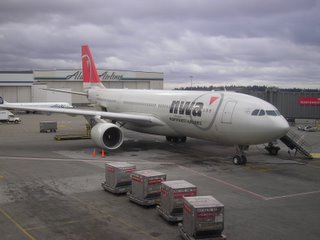
I caught Northwest Airlines flight 34 from Seattle. It was my first time on the A330, and it's a very nice airplane. I was planning on taking Northwest back to the states but ran into problems: KLM, which runs their gate in AMS, didn't have any jumpseat forms. I ended up jumpseating on USAirways to PHL, then taking Southwest PHL-MDW-PDX.
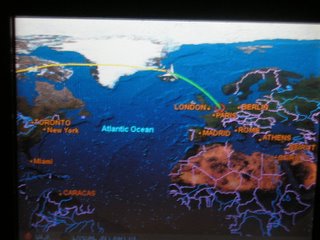
The A330's seatback entertainment system is cool! I built a playlist from the extensive music track collection, let it play, and set the map up for "follow the flight." Here we are 7 hours in, with three hours to go.
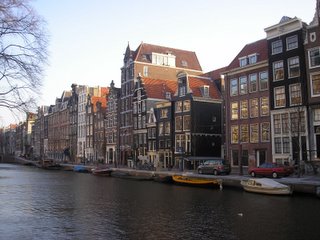
Sunrise over the stately homes alongside the Prinsengracht canal.
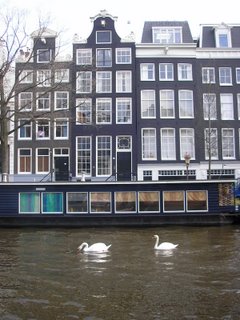
Swans swimming past a houseboat on the Prinsengracht canal.


The narrow pedestrian-only street of Nieuwendijk, where the Flying Pig hostel is located among numerous small shops, cafes, "coffee shops," and "head / smart stores."

Funny, I didn't see anyone drinking coffee in here... [grin]
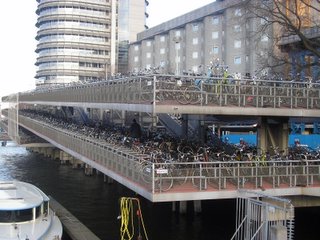
Somebody told me that the Dutch are avid bicyclists but I don't really believe it...
So yup. That's what you can do with jumpseat privledges, a few days off, and €70. Mind you, if you're not single, you'll need a loving wife/partner that urges you to travel somewhere on days off while they're working. Thanks, Dawn!
It was my first time in Amsterdam and I loved it. It's a very cool town - even if you're not into weed or prostitutes! I had fun just walking around and enjoying the laid back atmosphere, and meeting some cool people at the Flying Pig Hostel.

I caught Northwest Airlines flight 34 from Seattle. It was my first time on the A330, and it's a very nice airplane. I was planning on taking Northwest back to the states but ran into problems: KLM, which runs their gate in AMS, didn't have any jumpseat forms. I ended up jumpseating on USAirways to PHL, then taking Southwest PHL-MDW-PDX.

The A330's seatback entertainment system is cool! I built a playlist from the extensive music track collection, let it play, and set the map up for "follow the flight." Here we are 7 hours in, with three hours to go.

Sunrise over the stately homes alongside the Prinsengracht canal.

Swans swimming past a houseboat on the Prinsengracht canal.

The Royal Palace in Dam Square.

The narrow pedestrian-only street of Nieuwendijk, where the Flying Pig hostel is located among numerous small shops, cafes, "coffee shops," and "head / smart stores."

Funny, I didn't see anyone drinking coffee in here... [grin]

Somebody told me that the Dutch are avid bicyclists but I don't really believe it...
So yup. That's what you can do with jumpseat privledges, a few days off, and €70. Mind you, if you're not single, you'll need a loving wife/partner that urges you to travel somewhere on days off while they're working. Thanks, Dawn!
Thursday, February 23, 2006
Tuesday, February 21, 2006
One Year Old
Break out the balloons, party hats, and noisemakers; Blogging at FL250 turns one year old today. Thanks to everyone who's read and taken the time to comment or email, I really do appreciate your interest and input.
Sunday, February 19, 2006
The Right Approach
One of the more common questions we get from flight deck visitors is "how do you find the airport?" It's a good question, but it doesn't have a short answer. We have many ways of finding the desired patch of terra firma to land on, with technology ranging from rather crude to bleeding edge. Here's a discussion for those of you not familiar with IFR flying.
The majority of the time we simply fly visual approaches. As it's name would seem to indicate, a visual approach is flown by visual reference to the airport...simply "eye-balling it." Good weather is required, particularly in mountainous areas. The key is planning your descent so that you arrive at pattern altitude just far enough from the airport to slow down and configure for landing. If you find yourself too high to make a normal descent, a visual approach allows you to maneuver (S-turns, 360's, etc) or reconfiguring the airplane for higher drag.
When clouds or poor visibility preclude a visual approach, we'll shoot an instrument approach instead. I'll get to the various types of instrument approaches in a minute, but there are some shared characteristics to mention. All instrument approaches are created, tested, approved, and published by the FAA. At most airlines, pilots use "Jepp Charts," but these are simply another representation of the FAA-published data for each approach. Every approach has a standard course that each airplane must fly, as well as "feeder routes" and instructions in case of a "missed approach." There is a minimum visibility value that must be met before airline operators can even begin the approach. Finally, and quite importantly, there is a published minimum altitude based on obstructions and terrain. You cannot descend below this altitude until the airport is in sight.
The most common instrument approach is an ILS (Instrument Landing System). An ILS uses ground-based antennas to transmit several signals that guide airplanes right to the end of the runway. The localizer signal provides lateral ("right or left") guidance. The glideslope signal provides vertical guidance, usually for a 3 degree glidepath. In the airplane, these signals are picked up by a receiver and displayed for the pilot in the form of needles. The pilot follows the ILS to the ground by following the needles. For example, if the localizer needle is to the right, the pilot needs to go right to get on course. If the glideslope needle is down, the pilot needs to steepen the descent to get on glidepath. Both localizer and glideslope are quite sensitive; for this reason, a ILS approach usually provides a minimum altitude of 200 feet above touchdown elevation.
At my airline, we actually have extra equipment installed that allows us to fly special ILS approaches that have minimum altitudes of 50 to 100 feet above touchdown elevation. These are known as Category II and III ILS approaches ("Cat II" or "Cat III"). Most airlines use autoland-capable autopilots to fly Cat II/III approaches; at my airline we hand-fly these approaches using heads-up displays like you'd find in a military fighter. Only large airports, and some fog-prone smaller airports, have published Cat II/III approaches. Airports that don't have them are often inaccessible during fog.
The basic enroute navigational aid in the United States is the VOR - Very High Frequency Omnidirectional Range, if you care. Besides it's role in enroute navigation, this navaid also is used for VOR approaches. These are tricker than ILS's because there is no vertical guidance, so you descend in steps as you cross certain points on the approach. You navigate laterally with the same needle you'd fly an ILS with, except that you need to select the course. The lack of a glideslope, as well as the fact that VORs aren't nearly as sensitive as localizers, means that VOR approaches usually have much higher minimums than ILS approaches. Some airports are served by only VOR approaches, but they are rare in the airline world. Most of the airports we fly to have other approaches, and VOR's are just a backup to those.
The dinosaur of navaids is the non-directional beacon, or NDB. The NDB approach is like the VOR approach in that it lacks a glideslope, so descents must be made in steps. NDBs aren't very precise, so NDB approaches often have quite high minimums.
A relatively new option is the FMS approach. In general aviation these are known as GPS approaches, but at the airlines they are usually flown with a Flight Management System that utilizes GPS signals. In my airplane, FMS approaches provide both lateral and vertical guidance, just like an ILS - you follow the needles the same way. Some FMS approaches are "standalone," meaning that they were specifically designed to be FMS approaches; "overlay approaches" are actually laid over an existing VOR or NDB approach. In this case, you still use the VOR or NDB minimums, but at least you have the added safety and convenience of a glidepath.
The newest up-and-coming thing is RNP Approaches. These are similar to FMS approaches, in that they are dependent on GPS for navigation, but are more precise and incorporate neat things like curved or zigzagged courses. This will allow for low minimum altitudes, even in high terrain where an ILS would be impossible. Our sister airline is already using RNP approaches, and I'm told that we'll be getting approval sometime within the next year.
So what approach do we use? Whichever is most convenient and provides acceptible minimums given current weather conditions. Usually if there is an ILS available, we'll use it. If an FMS approach is quicker and the weather isn't too bad, we'll use that. We tend to stay away from VOR or NDB approaches unless the weather is pretty good or no other approach is available; of course, most of these approaches now have FMS approaches overlaid, so they're a lot easier these days. Of course, no matter which approach we use, we can't go below the minimum altitude until we see the airport. So once the gadgetry "finds the airport," it's back to good ole fashioned eye-ballin' it to safely land.
The majority of the time we simply fly visual approaches. As it's name would seem to indicate, a visual approach is flown by visual reference to the airport...simply "eye-balling it." Good weather is required, particularly in mountainous areas. The key is planning your descent so that you arrive at pattern altitude just far enough from the airport to slow down and configure for landing. If you find yourself too high to make a normal descent, a visual approach allows you to maneuver (S-turns, 360's, etc) or reconfiguring the airplane for higher drag.
When clouds or poor visibility preclude a visual approach, we'll shoot an instrument approach instead. I'll get to the various types of instrument approaches in a minute, but there are some shared characteristics to mention. All instrument approaches are created, tested, approved, and published by the FAA. At most airlines, pilots use "Jepp Charts," but these are simply another representation of the FAA-published data for each approach. Every approach has a standard course that each airplane must fly, as well as "feeder routes" and instructions in case of a "missed approach." There is a minimum visibility value that must be met before airline operators can even begin the approach. Finally, and quite importantly, there is a published minimum altitude based on obstructions and terrain. You cannot descend below this altitude until the airport is in sight.
The most common instrument approach is an ILS (Instrument Landing System). An ILS uses ground-based antennas to transmit several signals that guide airplanes right to the end of the runway. The localizer signal provides lateral ("right or left") guidance. The glideslope signal provides vertical guidance, usually for a 3 degree glidepath. In the airplane, these signals are picked up by a receiver and displayed for the pilot in the form of needles. The pilot follows the ILS to the ground by following the needles. For example, if the localizer needle is to the right, the pilot needs to go right to get on course. If the glideslope needle is down, the pilot needs to steepen the descent to get on glidepath. Both localizer and glideslope are quite sensitive; for this reason, a ILS approach usually provides a minimum altitude of 200 feet above touchdown elevation.
At my airline, we actually have extra equipment installed that allows us to fly special ILS approaches that have minimum altitudes of 50 to 100 feet above touchdown elevation. These are known as Category II and III ILS approaches ("Cat II" or "Cat III"). Most airlines use autoland-capable autopilots to fly Cat II/III approaches; at my airline we hand-fly these approaches using heads-up displays like you'd find in a military fighter. Only large airports, and some fog-prone smaller airports, have published Cat II/III approaches. Airports that don't have them are often inaccessible during fog.
The basic enroute navigational aid in the United States is the VOR - Very High Frequency Omnidirectional Range, if you care. Besides it's role in enroute navigation, this navaid also is used for VOR approaches. These are tricker than ILS's because there is no vertical guidance, so you descend in steps as you cross certain points on the approach. You navigate laterally with the same needle you'd fly an ILS with, except that you need to select the course. The lack of a glideslope, as well as the fact that VORs aren't nearly as sensitive as localizers, means that VOR approaches usually have much higher minimums than ILS approaches. Some airports are served by only VOR approaches, but they are rare in the airline world. Most of the airports we fly to have other approaches, and VOR's are just a backup to those.
The dinosaur of navaids is the non-directional beacon, or NDB. The NDB approach is like the VOR approach in that it lacks a glideslope, so descents must be made in steps. NDBs aren't very precise, so NDB approaches often have quite high minimums.
A relatively new option is the FMS approach. In general aviation these are known as GPS approaches, but at the airlines they are usually flown with a Flight Management System that utilizes GPS signals. In my airplane, FMS approaches provide both lateral and vertical guidance, just like an ILS - you follow the needles the same way. Some FMS approaches are "standalone," meaning that they were specifically designed to be FMS approaches; "overlay approaches" are actually laid over an existing VOR or NDB approach. In this case, you still use the VOR or NDB minimums, but at least you have the added safety and convenience of a glidepath.
The newest up-and-coming thing is RNP Approaches. These are similar to FMS approaches, in that they are dependent on GPS for navigation, but are more precise and incorporate neat things like curved or zigzagged courses. This will allow for low minimum altitudes, even in high terrain where an ILS would be impossible. Our sister airline is already using RNP approaches, and I'm told that we'll be getting approval sometime within the next year.
So what approach do we use? Whichever is most convenient and provides acceptible minimums given current weather conditions. Usually if there is an ILS available, we'll use it. If an FMS approach is quicker and the weather isn't too bad, we'll use that. We tend to stay away from VOR or NDB approaches unless the weather is pretty good or no other approach is available; of course, most of these approaches now have FMS approaches overlaid, so they're a lot easier these days. Of course, no matter which approach we use, we can't go below the minimum altitude until we see the airport. So once the gadgetry "finds the airport," it's back to good ole fashioned eye-ballin' it to safely land.
Friday, February 17, 2006
Freak Accident
Ground damage is a pretty common occurance in the airline world. Bag loaders, service trucks, and even gates regularly punch holes in airplanes. A few months ago, our sister airline suffered a depressurization incident caused by unreported ground damage, so it's a bit of a sensitive subject at our company. Besides the safety factor, ground damage costs airlines a lot of money, and it's mostly preventable. It's usually caused by time-pressed employees who get careless and make mistakes.
On Tuesday, though, I was involved in a ground damage incident that probably qualifies for freak occurence status. A chain of seemingly unrelated factors came together and resulted in a bent airplane. It started when we were deiced in Butte, resulting in a smudged windshield. Inbound to Seattle, we called for a window wash. I made a nice Flaps 15 landing and lowered the nosewheel softly; although I didn't realize it, the nosewheel strut did not compress fully.
At the parking spot, one of our ramp supervisors placed a wheeled ladder against the airplane to do the window wash. These ladders have padded handrails to prevent damage, but there are some sharp corners lower on the ladder. When it was first positioned, these corners were several inches below and away from the curved side of the airplane. The problem arose when enough passengers boarded to cause the nose strut to finally compress. The nose of the airplane sank several inches onto a corner of the ladder, which caused a nasty gash in the skin.
The airplane was taken out of service; fortunately, another airplane was available to get us on our way. I don't know how anybody could've foreseen this occurence; the ramp supervisor certainly wasn't negligent. Given the sensitivity of the ground damage issue these days, I was a little worried that he'd be tarred and feathered, despite being one of the friendliest and hardest working ramp sup's we have anywhere. It sounds like the company is dealing with it pretty reasonably, though.
Given how strong our airplanes are to structural loads, it can be alarming to see how susceptible their aluminum skin is to gouging and tearing. Fortunately, there aren't many things in the sky that gouge or tear, so we just have to look out for bag loaders and sharp edged ladders on the ground.
On Tuesday, though, I was involved in a ground damage incident that probably qualifies for freak occurence status. A chain of seemingly unrelated factors came together and resulted in a bent airplane. It started when we were deiced in Butte, resulting in a smudged windshield. Inbound to Seattle, we called for a window wash. I made a nice Flaps 15 landing and lowered the nosewheel softly; although I didn't realize it, the nosewheel strut did not compress fully.
At the parking spot, one of our ramp supervisors placed a wheeled ladder against the airplane to do the window wash. These ladders have padded handrails to prevent damage, but there are some sharp corners lower on the ladder. When it was first positioned, these corners were several inches below and away from the curved side of the airplane. The problem arose when enough passengers boarded to cause the nose strut to finally compress. The nose of the airplane sank several inches onto a corner of the ladder, which caused a nasty gash in the skin.
The airplane was taken out of service; fortunately, another airplane was available to get us on our way. I don't know how anybody could've foreseen this occurence; the ramp supervisor certainly wasn't negligent. Given the sensitivity of the ground damage issue these days, I was a little worried that he'd be tarred and feathered, despite being one of the friendliest and hardest working ramp sup's we have anywhere. It sounds like the company is dealing with it pretty reasonably, though.
Given how strong our airplanes are to structural loads, it can be alarming to see how susceptible their aluminum skin is to gouging and tearing. Fortunately, there aren't many things in the sky that gouge or tear, so we just have to look out for bag loaders and sharp edged ladders on the ground.
Wednesday, February 15, 2006
Anybody up for some skiing?
This Friday and Saturday, Dawn and I are going to be heading to Big White Ski Resort in Kelowna, BC. Dawn doesn't want to ski on Saturday, and none of my friends have this weekend off, so I'm still looking for a ski buddy.
You can get a cheap bed ($24 CDN) at the ski-in/ski-out SameSun Big White Hostel. If you get into town Friday morning or afternoon, you catch a ride from Kelowna to Big White with us. Kelowna's airport is served by WestJet, Horizon Air, and Air Canada/Jazz. Big White gives airline employees a 25% discount on lift tickets. So, if you're in the mood for some light Okanagan powder, drop me an email.
EDIT: Scatch that. All the rental car places are sold out so we'd have no way to get to the mountain. Guess we're gonna hang around here and ski locally.
You can get a cheap bed ($24 CDN) at the ski-in/ski-out SameSun Big White Hostel. If you get into town Friday morning or afternoon, you catch a ride from Kelowna to Big White with us. Kelowna's airport is served by WestJet, Horizon Air, and Air Canada/Jazz. Big White gives airline employees a 25% discount on lift tickets. So, if you're in the mood for some light Okanagan powder, drop me an email.
EDIT: Scatch that. All the rental car places are sold out so we'd have no way to get to the mountain. Guess we're gonna hang around here and ski locally.
Tuesday, February 14, 2006
The Turbulence Switch
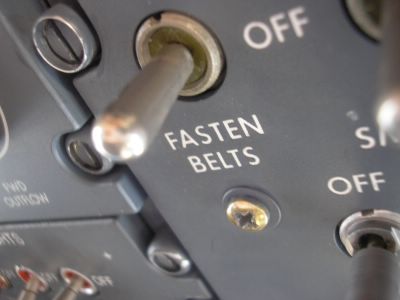
It's an airline truism that the seatbelt sign switch doubles as a turbulence switch. As soon as you turn it off, the turbulence begins. If you make a PA announcing that "we're expecting a smooth ride today," you can expect the bumps to be doubly nasty.
This switch carries a lot of liability with it. If a passenger is injured in turbulence, the first question the captain will be asked is "did you have the seatbelt sign off?" A few of the captains I fly with never turn the seatbelt sign off for this very reason. The thinking is this: If a passenger really needs the lavatory, they'll get up regardless of the switch position. That's true, many passengers disregard the seatbelt sign altogether. That's fine when it's not that bad and the captain is being overcautious, but the passengers have no way to distinguish between these times and when they really need to be seated for safety's sake. Always leaving the sign on might cover the captain's posterior, but it's not desirable for safety. Besides, it's not good customer service.
Many captains leave the seat belt sign up to the non-flying pilot. My own policy is to turn it off whenever we're in obviously smooth air above FL180, or if we're in light chop that shows no signs of getting worse. Whenever worsening turbulence forces me to turn the sign back on, I'll make a PA stating the reason that the passengers need to stay seated. On a few occasions, I've heard passengers entering the lavatory during solid moderate turbulence (it's right behind my seat), so I made PAs to tell the passengers that "you really need to stay seated with your seatbelts fastened right now."
A related "CYA" vs. customer service issue relates to the flight attendents. On flights over 30 minutes long, they'll do a snack and beverage service by default. If you're expecting moderate turbulence over the course of the flight, you'll ask them to remain seated and make a PA announcing that there will be no service on this flight due to turbulence. Of course, this is one way to ensure a silky smooth ride. The more common route is to tell the flight attendants to remain seated until you're climbing through 10,000 feet, at which time you can evaluate the turbulence so far and tell them whether to serve or not. The last thing you want is to hit moderate to severe turbulence while the FAs are pushing a heavy serving cart down the aisle.
Of course, the pilots can't always anticipate when it's going to be turbulent. I remember one of my flights from a few months back where there were no PIREPs or AIRMETs for turbulence. We had a smooth climbout from Portland until we reached FL230, where we hit a sudden band of clear air turbulence - moderate bordering on severe. My first thought was "oh crap, I'm sure we have a hurt FA or two." I called back to check on them. Luckily, they hadn't begun service yet and were still strapped into their jumpseats. If it'd been a shorter flight, they would've had the serving cart in the aisle already. The other thing was that I'd been just about to turn the seatbelt sign off.
Most turbulence can be seen and anticipated, but clear-air events like this do happen periodically. It's the reason why most airlines ask that passengers keep their seatbelts fastened while seated, even if the seatbelt sign is off. It's cheap insurance against a very real risk of serious injury.
Sunday, February 12, 2006
Great White North?
I have a trip starting today that overnights in Edmonton, Butte, and Edmonton again. It's been so nice around here that I really wasn't looking forward to heading up to Canada with all the snow and cold, etc. But then I pulled up the most recent METAR for Edmonton:
CYEG 122000Z 29013KT 15SM FEW120 BKN250 11/M08 A3007 RMK AC1CI1 SLP214
(translation: winds northwest at 15mph, good visibility, mostly sunny skies, 52 degrees Farenheit.)
Well sheesh. It's nicer up there than it is down here. And come to think of it, it's been nice every single time I've gone to Edmonton this winter. I haven't even had to put the inner lining into my flight jacket. Maybe I should bid more Canadian lines...
CYEG 122000Z 29013KT 15SM FEW120 BKN250 11/M08 A3007 RMK AC1CI1 SLP214
(translation: winds northwest at 15mph, good visibility, mostly sunny skies, 52 degrees Farenheit.)
Well sheesh. It's nicer up there than it is down here. And come to think of it, it's been nice every single time I've gone to Edmonton this winter. I haven't even had to put the inner lining into my flight jacket. Maybe I should bid more Canadian lines...
Thursday, February 09, 2006
Big Bad Bird
Red-tailed hawks are pretty big birds. There are a gaggle of them that hang around Brackett Field in SoCal, where I used to instruct and fly freight; I came close to hitting them on several occasions. I always wondered what kind of damage they'd inflict on a small airplane. Last week, I got to witness first-hand what they'll do to a MegaWhacker.
The MegaWhacker in question hit the hawk shortly before landing in Boise; I was supposed to fly that airplane out. As it taxied in, it became evident that we weren't going anywhere - there was a big hole in the side of the vertical stabilizer, with one huge hawk wing hanging out limply. The crew said that the impact shook the whole airplane. This happened on downwind, at about 200 knots. That's significantly below the MegaWhacker's Vmo (redline) for that altitude, so it wasn't even a worst-case scenario.
Today a friend told me that they're looking at up to six weeks to repair the airplane. Beyond the obvious hole in the tail, there was a fair amount of structural and internal systems damage. It's pretty amazing what a ten-pound bird will do to a fast-moving aircraft.
The MegaWhacker in question hit the hawk shortly before landing in Boise; I was supposed to fly that airplane out. As it taxied in, it became evident that we weren't going anywhere - there was a big hole in the side of the vertical stabilizer, with one huge hawk wing hanging out limply. The crew said that the impact shook the whole airplane. This happened on downwind, at about 200 knots. That's significantly below the MegaWhacker's Vmo (redline) for that altitude, so it wasn't even a worst-case scenario.
Today a friend told me that they're looking at up to six weeks to repair the airplane. Beyond the obvious hole in the tail, there was a fair amount of structural and internal systems damage. It's pretty amazing what a ten-pound bird will do to a fast-moving aircraft.
Pitch Down, Right Rudder
Today an acquaintance asked me about the origin of my email address (PitchDownRightRudder -at- hotmail dot com). Although it's easy to guess an aviation connection, the exact meaning isn't evident.
It dates back to my flight instructing days. With brand new student pilots, there is a marked tendancy to over-rotate on takeoff and to not correct for left turning tendancies. For the first few hours, it seems like you're constantly reminding your students about these things. Thus, the running joke among instructors at my flight school was that you only need to know one phrase to be a CFI - "Pitch Down, Right Rudder!"
It dates back to my flight instructing days. With brand new student pilots, there is a marked tendancy to over-rotate on takeoff and to not correct for left turning tendancies. For the first few hours, it seems like you're constantly reminding your students about these things. Thus, the running joke among instructors at my flight school was that you only need to know one phrase to be a CFI - "Pitch Down, Right Rudder!"
Wednesday, February 08, 2006
Cartoon Wars Spread
San Francisco (AP) -Update: More cartoon-related disrest in the US, reported by Iowahawk.
The worldwide furor over controversial political cartoons spread to the United States on Wednesday as thousands of animal rights activists took to the streets to protest a new cartoon that they say is a direct insult of their beliefs.
The cartoon in question depicted Garfield the Cat devouring several pans of lasagna that some claim appear to be meat-based. "You can clearly see the chunks of hamburger," explains People for Ethical Treatment of Animals (PETA) spokeshuman Lisa Lange. "It's against our beliefs to eat meat or allow depictions thereof. The publication of this cartoon is a slap in the face for trillions of PETA members nationwide."
Thousands of activists protested today at a PETA-organized rally at the Embarcadero. Many chanted together or beat drums; others wore handcuffs and chains to symbolize the oppression they say the cartoon represents. Among the many signs and banners present, oft-repeated slogans included "Freedom of Speech does NOT mean Freedom to Insult!" and "Down with Intolerant Fascist Lasagna-Peddling Carnivores!" The protest was mostly peaceful, although one youth was arrested for lobbing a molotov cocktail at Il Fornaio, an Italian restaurant on Battery Street.
Similar protests took place in Seattle, New York, and Washington DC. In New York, riot police fired rubber bullets and tear gas canisters at an angry mob as they pelted the headquarters of Garfield publisher Random House with raw lasagna noodles. In Washington, the Italian Embassy was hurriedly evacuated after an arsonist attempted to set the building on fire. The culprit was quickly arrested; his identity is unknown, although sources say he is a member of the Earth Liberation Front.
State and federal government officials are urging citizens to remain calm and not to take matters into their own hands. "These activists cannot be denied their right to free speech," explained Homeland Security Secretary Michael Chertoff. "As for the newspapers," he continued, "they should use more sensitivity in deciding what to publish. They should've thought before publishing something so hurtful to our bunnyhugging friends." Several senior Bush administration officials met with PETA leaders today to express their regret for the unfortunate Garfield cartoon.
Reaction throughout the press was varied. The New York Times responded by pulling future Garfield strips and printing an apology. "We are truly sorry for the pain that this venemous cartoon may have caused the non-animal eating community. As a token of our respect, we will be contributing $250,000 to PETA's action fund," reads part of the statement released today by the Times. Tomorrow's Washington Post will feature an op-ed by a PETA spokeshuman. The New York Sun, however, said it would include a free plate of meat lasagna with every newspaper sold tomorrow.
PETA's newsletter editor, Jo Miller King, said she would be soliciting cartoons depicting animals eating humans. "These [expletive] newspaper want to exercise free speech, we'll see how comfortable they are when the tables are turned!" King said. Meanwhile, PETA leadership is warning of a reactionary backlash against it's members and will hold a candlelight vigil for their safety tonight in Golden Gate Park.
Garfield cartoonist Jim Davis was unavailable for comment as he has gone into hiding after multiple threats on his life.
Tuesday, February 07, 2006
Montana Metroliner
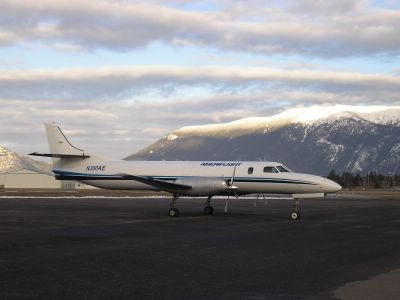
This weekend, Dawn and I visited our friends Jeremy and Crystal and baby Logan in Whitefish, MT. Jeremy and I go back to our flight instructing days, when we worked for the same school. He was hired at Ameriflight shortly before I left for my current company, and has flown for them ever since - currently as a SA227 Metroliner captain (and Be99 training captain). His route is stationed out of Kalispell, and he mostly flies to Missoula and Billings.
In aviation, there are few jobs that are harder than freight-dogging in a Metroliner, single pilot in the Montana Rockies, in the dead of winter. My airline used to fly SA227's in Montana, under part 121 with two pilot crews, and the pilots who did that remember it as some tough flying. After my company quit flying Metroliners, many of our airplanes found their way to Ameriflight. There, interiors replaced with sheet aluminum and cargo netting, they ply many of the same routes across the wintertime Rockies, guided by hardy souls like Jeremy.
You won't hear Jeremy complain about it. He says that the Metro is a great airplane for this kind of flying, with lots of power and good stablity, and a nice ride in turbulence. The airplane's notorious weaknesses - touchy ground handling, heavy control forces, "interesting" engine-out characteristics - are all things that can be handled with experience. A first officer comes in handy, he says, but isn't crucial. Ameriflight trains their captains for both single pilot and dual pilot operations, but the focus is on ensuring that the Metro pilots can safely handle the airplane by themselves in all situations.
As Jeremy preflights the airplane and supervises the loading of cargo, he notes a thin patch of ground fog just starting to form across the runway. "Bet it's going to be foggy tonight." Both Kalispell and Missoula are prone to fog; Billings is known for some wild winds. All three cities are subject to fierce snowstorms; in between them lies certain turbulence, icing, and lots of granite to avoid. There are plenty of ways to get yourself hurt out here; any pilot flying here on a daily basis needs to be smart and prepared. Jeremy is both, and flying the Metro here will make him only more so. This is experience that will serve him long after he moves on. It is turning him into the kind of pilot that everyone is glad to fly with on a dark and stormy night.

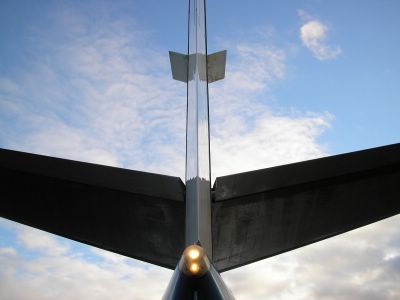
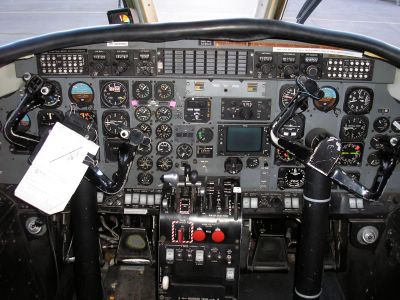

Big Mountain, Whitefish MT
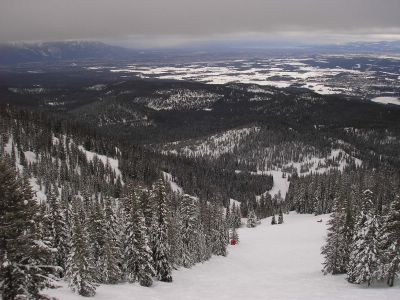
Very cool mountain with some beautifully groomed cruisers as well as extensive glades and steeps. I gotta say that it was a joy to ski on light Rocky Mountain snow instead of the usual Cascade Concrete. I think I need to visit more often...
Air crew, take note: show your airline I.D. and get $8 off your Big Mountain lift ticket. My freight dog bud Jeremy showed his Amflight ID and got the discount, too.
We'll get 'em next year, bud
Friday, February 03, 2006
More on airline pilots + light planes
Yesterday I was in Denver, visiting my buddy Chris. He's a CFI out of Jeffco Airport, where we rented a C152 and took it up for some landing practice. It'd been nearly ten months since I'd flown a single-engine airplane, so I wanted to get my single-engine currency back. I'm checked out locally at Troutdale, but decided it'd be more fun to visit Chris and fly with him.
As we strapped into the Cessna, I marveled at how tiny it seems. I learned to fly in a C150, but either the plane has been getting smaller or I've been getting bigger. My first few trips around the pattern, I was seriously overcontrolling - the control forces are much lighter than I'm used to. And it took all my willpower to bring the throttle all the way back to idle - the Megawhacker has given me the bad habit of carrying power all the way to touchdown. By the sixth or seventh trip around the pattern, my airline pilot habits were mostly broken and I was making some decent landings. Of course, the Megawhacker sits pretty close to the ground, and it still has props - I think getting back into a Cessna would be harder for, say, a B767 driver.
It's fairly rare to find an airline pilot that still flies light planes. Most just don't have the interest. "I fly around 100 hours a month for work," goes the typical explanation, "so why would I do it on my time off?" Yeah, that's understandable. It certainly applies to me at times. After a long trip chock-full of flying, you often want to get your mind off your job - in my case, skiing or hiking are great for that. Blogging - not so much, heh.
Still, light plane flying is really a completely different world from airline flying, particularly if you get into classic taildraggers, backcountry flying, aerobatics, gliders, or just putt-putting around at low altitude in a Cessna. The small planes I fly are pretty simple, typically equipped only with a nav/com and transponder. When I go cross-country, it's VFR with map and compass. It's completely different from my job, and that makes it enjoyable to do for fun every once in a while.
A few of the captains I've flown with have their own airplanes. Only a couple of them fly light aircraft on a really regular basis. CP owns a C172 with his dad, and flies between his home and his Dad's airport quite often. JK has a Piper PA22/20 Pacer that's equipped with a towhook for gliders. When not towing gliders, he flies them occasionally, and is also active in hang-gliding. He's the exception to the rule: an airline pilot that enthusiastically pursues aviation as a hobby. We have fun talking planes when we fly together.
I don't think I've mentioned it here, but Ameriflight recently terminated my Part Time on Call status. They just weren't using me enough to justify the training costs. So, no more free Chieftain flying for me. I've kept my CFI certificate current, though, and might do a little instructing on the side.
As we strapped into the Cessna, I marveled at how tiny it seems. I learned to fly in a C150, but either the plane has been getting smaller or I've been getting bigger. My first few trips around the pattern, I was seriously overcontrolling - the control forces are much lighter than I'm used to. And it took all my willpower to bring the throttle all the way back to idle - the Megawhacker has given me the bad habit of carrying power all the way to touchdown. By the sixth or seventh trip around the pattern, my airline pilot habits were mostly broken and I was making some decent landings. Of course, the Megawhacker sits pretty close to the ground, and it still has props - I think getting back into a Cessna would be harder for, say, a B767 driver.
It's fairly rare to find an airline pilot that still flies light planes. Most just don't have the interest. "I fly around 100 hours a month for work," goes the typical explanation, "so why would I do it on my time off?" Yeah, that's understandable. It certainly applies to me at times. After a long trip chock-full of flying, you often want to get your mind off your job - in my case, skiing or hiking are great for that. Blogging - not so much, heh.
Still, light plane flying is really a completely different world from airline flying, particularly if you get into classic taildraggers, backcountry flying, aerobatics, gliders, or just putt-putting around at low altitude in a Cessna. The small planes I fly are pretty simple, typically equipped only with a nav/com and transponder. When I go cross-country, it's VFR with map and compass. It's completely different from my job, and that makes it enjoyable to do for fun every once in a while.
A few of the captains I've flown with have their own airplanes. Only a couple of them fly light aircraft on a really regular basis. CP owns a C172 with his dad, and flies between his home and his Dad's airport quite often. JK has a Piper PA22/20 Pacer that's equipped with a towhook for gliders. When not towing gliders, he flies them occasionally, and is also active in hang-gliding. He's the exception to the rule: an airline pilot that enthusiastically pursues aviation as a hobby. We have fun talking planes when we fly together.
I don't think I've mentioned it here, but Ameriflight recently terminated my Part Time on Call status. They just weren't using me enough to justify the training costs. So, no more free Chieftain flying for me. I've kept my CFI certificate current, though, and might do a little instructing on the side.
Airline Pilot in a Cessna
One of the scariest things in aviation!

The others are doctors in Bonanzas & lawyers in Mooneys.
Man, every time I fly the C152, I can't believe how small it is.
I normally wouldn't fly a C152 at max gross weight out of Jeffco Airport in Denver, but it was cold so we got a good 300 fpm climb out of it!

The others are doctors in Bonanzas & lawyers in Mooneys.
Man, every time I fly the C152, I can't believe how small it is.
I normally wouldn't fly a C152 at max gross weight out of Jeffco Airport in Denver, but it was cold so we got a good 300 fpm climb out of it!
Subscribe to:
Posts (Atom)




